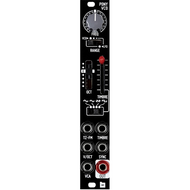Pony VCO - Befaco
by Ellison Wolf
Pony’s are usually associated with twelve year-olds’ birthday parties, Renaissance fairs, and petting zoos, and because of that, you might think that Befaco’s miniscule new VCO [only 4HP!] would be kind of a beginner, entry level, cute little thing for newbs or something, a friendly way to ease the skittish into modular, but that’s simply not the case. Not even close. Well, it is kind of cute—as well as a near marvel of PCB SMD layout—but this Pony is way more powerful than you might think at first glance.
Pony is an all-analog Buchla-inspired VCO with 10Vp-p Thru-Zero modulation [TZ-FM], a Timbre [wavefolding] control, four selectable waveshapes [sine, triangle, ramp, and square], and a built-in VCA. There’s 1V/Oct tracking that has an eight-octave range, a Hard Sync input, a manual Frequency control, with a lone Output. With a selectable Range of four options [Full, Octave, Semitone [with a one-semitone span], and LFO] that affect the manual Frequency control, there are a lot of possibilities here. Patching in CV to the 1V/Oct overrides the Frequency, Octave, and Range controls.
I’ve always loved the Buchla style VCOs found on Music Easels and the newer Easel Command, with their sliding timbre control. It’s sort of the West Coast version of the East Coast Filter Sweep, or perhaps it’s the other way around. Either way, I prefer the timbre slide over the filter sweep as there’s a certain going-through-a-tunnel metallic electricity that comes from wavefolding, from seeing and hearing a wave collapse on itself, that is so satisfying, and Pony doesn’t disappoint in this realm. Whether it’s a sine, triangle, ramp, or square Pony folds with the best of them. FYI, when you’re in square wave mode the Timbre control adjusts the wave’s pulse width, and if you go to extremes with the Timbre slider while doing so, the voltage remains constant at about +5V at the top and -5V the bottom with no change [unless you have CV patched in], which means no frequency, which means no sound! PWM fundamentals! Also, the Timbre CV input adds voltage to the position of the Timbre control, so how your patched-in CV affects the overall shape is dependent on the slider positioning.
Pony uses a Sound Semiconductor SSI2130 VCO as its core—a very stable chip—so for melodic purposes it works really well. Just for fun I ran Pony through the Mordax DATA’s tuner and it was really stable, with hardly any pitch fluctuation while holding a note, no matter the waveshape/form, and it was consistent every time my sequencer [Winter Modular’s Eloquencer in this case] jumped from note to note. There’s really nothing like TZ-FM to create otherwise unobtainable tones in the analog realm, and again, Pony excels here as the Thru-Zero kept in tune quite well.
Pony sounds fantastic and I almost can’t believe how much range, functionality, diversity of tone, and usability this small module offers up. Not to mention having an onboard VCA is totally handy; and using Pony as an LFO is completely worthwhile, very nearly a game changer if you’re used to typical LFO offerings or just using some random voltage. And using Pony to audio rate FM another oscillator while being modulated to the hilt makes you realize why we’re all in this to begin with. Pony might just be the most powerful 4HP VCO I’ve ever used, and definitely the most powerful pony I’ve come across. No need to wait until your next birthday to get yerself a Pony, it’s available now in either a 3U or 1U format.
3U 4 HP +12v 32mA -12v 25mA
1U 24HP +12v 32mA -12v 25mA
Price: $199


